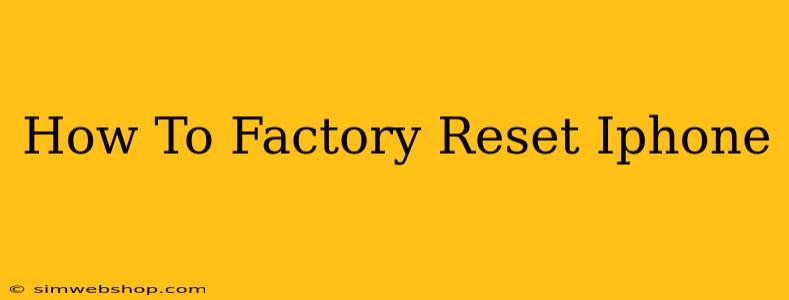Facing a problematic iPhone? A factory reset might be your solution. This comprehensive guide walks you through the process of completely erasing your iPhone, returning it to its original factory settings. Whether you're selling your device, troubleshooting issues, or simply starting fresh, we'll cover everything you need to know.
Understanding the Factory Reset Process
A factory reset, also known as a master reset, completely wipes your iPhone's data and settings. This includes:
- Apps and Data: All your downloaded apps, photos, videos, documents, and other files will be deleted.
- Settings: Personalized settings like Wi-Fi passwords, notifications, and accessibility options will be reset to their defaults.
- Accounts: Your Apple ID and other linked accounts will be removed.
Important Note: Before proceeding, back up your important data! This is crucial to avoid losing irreplaceable information. You can back up your iPhone using iCloud or a computer with iTunes (or Finder on macOS Catalina and later).
Methods for Factory Resetting Your iPhone
There are several ways to factory reset your iPhone, depending on your device's condition and your preferences.
Method 1: Resetting Through Settings (Most Common)
This is the most common and generally recommended method.
- Open the Settings app: Find the grey icon with gears on your home screen.
- Tap "General": Scroll down and select this option.
- Tap "Transfer or Reset iPhone": This option is usually towards the bottom of the General settings menu.
- Tap "Erase All Content and Settings": You'll be prompted to enter your passcode for verification.
- Confirm the reset: Apple will display a final warning, reminding you that all data will be erased. Tap "Erase iPhone" to proceed.
Method 2: Resetting Using iTunes or Finder (For Disabled iPhones)
If your iPhone is disabled or you're encountering other issues preventing you from accessing settings, this method might be necessary.
- Connect your iPhone to your computer: Use a USB cable.
- Open iTunes (or Finder on macOS Catalina and later): Your iPhone should be detected.
- Select your iPhone: Click on the iPhone icon in the iTunes/Finder window.
- Click "Restore iPhone": This will erase all data and restore your iPhone to factory settings. Again, ensure you've backed up your data beforehand.
Method 3: Resetting using iCloud (If Find My is Enabled)
If you have enabled Find My iPhone, you can erase your device remotely. This requires you to have an internet connection:
- Go to iCloud.com on your computer or another device.
- Log in with your Apple ID and password.
- Click on "Find iPhone".
- Select your iPhone from the list of devices.
- Click on "Erase iPhone". This will remotely erase your device.
After the Factory Reset
Once the reset is complete, your iPhone will restart and appear as new. You'll need to go through the initial setup process, connecting to Wi-Fi and signing in with your Apple ID. Then, you can restore your data from a backup if you created one.
Troubleshooting Common Issues
- Unable to access settings: If your iPhone is disabled or unresponsive, try resetting using iTunes or Finder.
- Forgot your passcode: If you've forgotten your passcode, you might need to restore your iPhone using iTunes or Finder, which will erase your data.
- Resetting takes too long: This can be due to a large amount of data or connectivity issues. Be patient and ensure your device is connected to power.
Following these steps will allow you to successfully factory reset your iPhone. Remember to back up your data to avoid losing valuable information. If you encounter any significant problems, consider contacting Apple Support for assistance.

